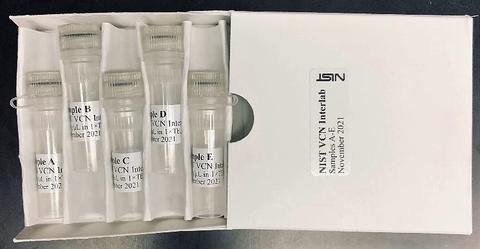Integrated Lentiviral Vector Copy Number Measurements: Invitation to Participate in an Interlaboratory Testing Program Evaluating Genomic DNA Test Materials
Summary
NIST invites participants to an Interlaboratory Testing Program to evaluate the suitability and utility of the genomic DNA test materials to serve as reference materials or controls for the measurements of the integrated lentiviral vector copy number (VCN) into the genome of target cells.
GOALS OF THE INTERLAB STUDY
NIST will provide the DNA samples free of charge to the participants for their evaluation using their own measurement methods. The laboratories will measure VCN using the measurement techniques of their choice and NIST will coordinate the study and provide data analysis of the data provided by the participants. The results of the interlaboratory study will be published in a peer reviewed open-source scientific journal. The results of individual laboratories will be anonymized when published. The participants will have the opportunity to be authors on the publication. Depending upon the results of the study and feedback from participants, NIST may develop reference materials from the cell lines.
INTERLAB STUDY PARTICIPATION IS NOW CLOSED
- Results from interlaboratory study will be made publicly available upon the completion of this study.
Description

NIST has produced genomic DNA test materials from transduced Jurkat cell lines with integrated lentiviral vector copy number (VCN) for evaluation as a candidate reference material. Transducing Jurkat (Clone E6-1) cell lines with a lentivirus expressing a green fluorescent protein were produced by Lentigen Technology Inc. (a Miltenyl Biotec Company). The transduced Jurkat cells were clonally isolated to produce stable cell lines with N=1, N=2, N=3, and N=4 copies of the integrated provirus. Cell lines were expanded and used to prepare candidate reference genomic DNA material from the parental cell line (N=0) and the transduced cell lines.
NIST Characterization
The DNA concentration was determined using absorbance (260 nm), fluorescent dye binding, and digital PCR assays for reference genes (based on assays validated at NIST). The identity of the cell lines was confirmed by STR profiling. The lentiviral copy number was confirmed by digital PCR assays as previously described (Paugh et al. 2021) and assays developed in the NIST labs.
SAMPLES
DNA prepared from the cell lines was suspended in 1X TE buffer (10 mM TRIS 1 mM EDTA pH 8.0) at a concentration of approximately 25 ng/µL (nominal concentration was measured) and stored at 4 ⁰C. The test set will consist of 5 vials containing genomic DNA extracted from the VCN cell lines, each vial will contain 80 µL of genomic DNA at a total of approximately 2 µg DNA. Samples will be shipped on cold packs.
Responsibilities for Joining the Interlaboratory Study
By joining this research study and accepting the samples, you agree to the following:
- Return the results to the NIST contact organizers within 30 days after receiving the samples. If you require additional time, contact the NIST organizers and let them know how long you will require.
- A results template will be provided in which you will provide the details of how the samples were used and the results. If the methods and details used in the measurements are proprietary you can respond with that option and not disclose those details.
- You agree to provide NIST with feedback on the utility of the materials for your applications. It is extremely important to NIST to learn if the materials are useful and if can they be improved.
- Store the materials protected from light at 4 ⁰C. Analyze the samples using your measurement method at least twice, triplicate measurements are better to determine reproducibility. If possible, replicates should be done on different days, operators, and instruments.
- Complete the results template (Goggle form) providing as much information as possible and return to NIST.
- NIST will unblind the samples and provide you with a summary of your company results. NIST will not reveal the results of other participants, and any reports and publications of the results will be blinded to the identity of the participants.
- Provide the shipping address, and contact information for the person receiving the samples and the contact for the contact person responsible for reporting the results.
Reference
Barbara S. Paugh, Lajos Baranyi, Andre Roy, Hua‑Jun He, Lindsay Harris, Kenneth D. Cole, Moria Artlip, Caroline Raimund, Patricia S. Langan, Srikanta Jana, Rimas J. Orentas, Sheng Lin‑Gibson, Winfried Krueger, and Boro Dropulić. “Reference standards for accurate validation and optimization of assays that determine integrated lentiviral vector copy number in transduced cells”, Scientific Reports (2021) 11, article Number 389, https://doi.org/10.1038/s41598-020-79698-w

